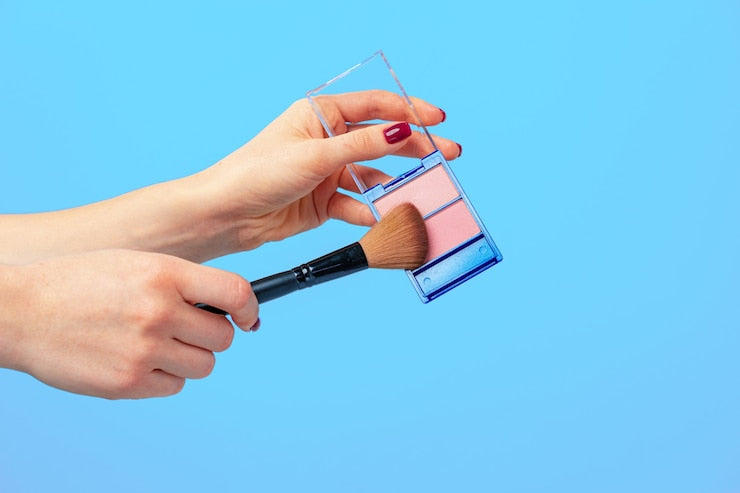
Makeup Brush Guide: Types, Uses, and Cleaning Tips
Share
A flawless makeup application begins with the right tools, and makeup brushes are among the most essential. Whether you're a beauty beginner or a seasoned makeup enthusiast, understanding the various types of brushes, their uses, and how to maintain them can elevate your makeup routine to a professional level. At Glamoora, we believe that beauty starts with knowledge. This comprehensive guide will walk you through everything you need to know about makeup brushes.
Understanding the Basics of Makeup Brushes
Makeup brushes are designed with different shapes, sizes, and bristle types to serve specific purposes. Each brush is crafted to help apply makeup products with precision, blend them seamlessly, and enhance the overall finish.
Types of Bristles
There are two main types of bristles used in makeup brushes:
-
Natural Bristles – These are typically made from animal hair and are ideal for applying powder-based products. They have a textured surface that helps grip and distribute pigment evenly.
-
Synthetic Bristles – Made from man-made fibers like nylon or polyester, synthetic bristles are perfect for liquid or cream products. They are also a cruelty-free alternative to natural bristles.
Both types have their place in a well-rounded brush collection, and the choice depends on the products you use and your personal preferences.
Essential Makeup Brushes and Their Uses
There are countless types of makeup brushes on the market, but not all are necessary. Here are the most essential brushes that every makeup kit should include:
1. Foundation Brush
Used to apply liquid or cream foundation evenly across the face. Foundation brushes come in various shapes, such as flat, rounded, or stippling designs. Each shape provides a different finish, from full coverage to airbrushed effects.
2. Powder Brush
This large, fluffy brush is ideal for applying loose or pressed powder to set your foundation and reduce shine. It helps distribute powder evenly for a natural finish.
3. Blush Brush
Slightly smaller than a powder brush and often angled, the blush brush is designed to apply color to the cheeks, enhancing your natural flush.
4. Contour Brush
With a slanted or narrow shape, this brush is perfect for defining the cheekbones, jawline, and nose using contour powders or creams.
5. Highlighter Brush
A fan brush or tapered highlighting brush is used to apply highlighter to the high points of the face like the cheekbones, brow bones, and the bridge of the nose.
6. Eyeshadow Brushes
This category includes several smaller brushes:
-
Shader Brush: Applies eyeshadow to the lid.
-
Blending Brush: Softens edges and blends colors.
-
Crease Brush: Adds depth by applying shadow to the crease of the eyelid.
-
Detail Brush: For precision work, such as highlighting the inner corners of the eyes.
7. Eyeliner Brush
A small, angled brush used to apply gel or cream eyeliner for a defined lash line.
8. Brow Brush
This dual-ended brush includes a spoolie for brushing the brows and an angled brush for applying brow products like powder or pomade.
9. Lip Brush
A small, firm brush that allows for precise application of lipstick or lip gloss.
Choosing the Right Brush for Each Product
Choosing the correct brush enhances the performance of your makeup products. For example, using a dense, synthetic brush with liquid foundation helps buff the product into the skin, providing a flawless finish. Conversely, a soft, fluffy natural bristle brush works best for powders, offering a more diffused effect.
It’s important to note that brush quality also affects performance. Investing in high-quality brushes not only improves application but also ensures longevity and comfort during use.
How to Clean and Maintain Your Makeup Brushes
Clean brushes are essential for maintaining skin health and achieving smooth makeup application. Dirty brushes can harbor bacteria, oil, and product buildup, leading to breakouts and uneven finishes.
How Often Should You Clean Your Brushes?
-
Foundation and concealer brushes: At least once a week.
-
Eye brushes: Every 2–3 days, especially if used with different colors.
-
Powder brushes: Once every 1–2 weeks.
Cleaning Steps
-
Wet the bristles with lukewarm water. Avoid getting water on the handle to prevent loosening the glue that holds the bristles.
-
Apply a gentle cleanser or brush cleaner to the bristles.
-
Lather and swirl the brush on your palm or a cleaning mat.
-
Rinse thoroughly until water runs clear.
-
Gently squeeze out excess water and reshape the bristles.
-
Lay flat to dry, ideally with the bristles hanging off the edge of a counter to retain shape.
Additional Tips
-
Never soak your brushes entirely in water.
-
Avoid using harsh shampoos or bar soaps.
-
Use a daily brush cleaner spray for quick sanitation between uses.
When to Replace Your Brushes
Even with proper care, brushes don't last forever. Over time, bristles may fray, shed, or lose shape. Signs that it's time to replace a brush include:
-
Persistent shedding
-
Foul odor
-
Loss of performance or shape
-
Irritation on the skin
High-quality brushes, especially when well-maintained, can last for several years.
Final Thoughts
Understanding the types, uses, and maintenance of makeup brushes empowers you to get the most out of your beauty routine. With the right tools, you can apply makeup more precisely, achieve better results, and maintain healthier skin. At Glamoora, we support your beauty journey by offering products that complement and enhance your self-care rituals.
Keep your brushes clean, your tools organized, and your beauty routine intentional. It’s not just about looking good—it’s about feeling confident every step of the way.
Explore the collection
For more products
Glamoora 1 QuickClean Makeup Brush Cleaner
Glamoora Makeup Brush Cleaner & Dryer
